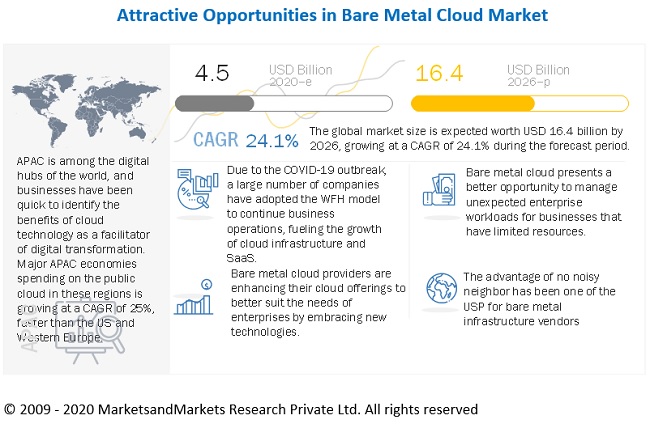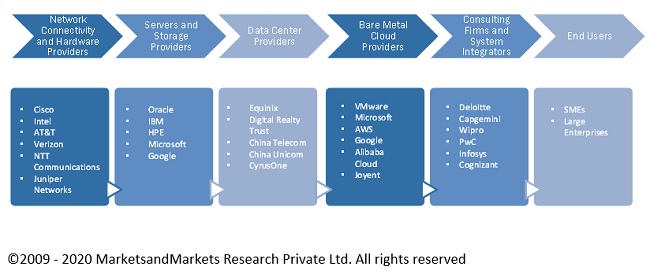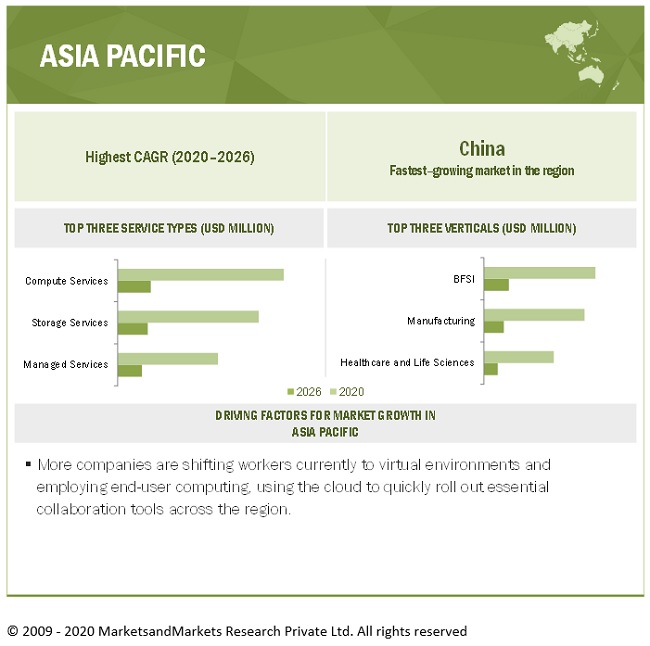< Key Hightlight >
The global Bare Metal Cloud market size is expected to grow at a Compound Annual Growth Rate (CAGR) of 24.1% during the forecast period, to reach USD 16.4 billion by 2026 from USD 4.5 billion in 2020. Major factors that are expected to drive the growth of the bare metal cloud market include increasing critical need for reliable load balancing of data-intensive and latency-sensitive operations, necessity of non-locking compute and storage resources, increased usage of IoT platforms and devices to manage workload with high performance computing, elimination of overheads caused due to adherence to compliance, convergence of technologies such as AI, IoT, and analytics, and increase in mobility usage among end users.

To know about the assumptions considered for the study, Request for Free Sample Report
COVID-19 Impact Bare Metal Cloud Market
The COVID-19 pandemic has affected every segment of society, including individuals and businesses. The technological ecosystem has been playing a pivotal role across the globe. Owing to the COVID-19 pandemic, the requirement of bare metal cloud services for businesses has increased significantly for load balancing to improve the distribution of workloads, customize networks for extensive performance, ensure high security of data, provide multiple database homes on a single server, optimize IT resource access and physical security, and achieve strategic business initiatives.
Bare Metal Cloud Market Dynamics
Drivers: Increased need for reliable load balancing of data-intensive and latency-sensitive operations
Load balancing improves the distribution of additional workloads across the bare metal cloud servers to enable smoother functioning and allocation of resources to multiple processes. Load balancing solutions enable ease in configurability and flexibility to manage traffic and resource usage across server nodes in the real-time end-user environment. Hence, it becomes critical to deploy reliable load balancing operations over the cloud.
Restraints: Lightweight Hypervisors
Virtual cloud computing providers are investing heavily in the R&D of hypervisors to make them more monolithic, lightweight, portable, and flexible. In addition to public cloud vendors are offering their dedicated instances of computing for high-performance workloads. These hypervisors provide high performance and low memory footprint virtualization solutions for multiple CPU architectures and have been termed as a cheap alternative for bare metal cloud infrastructure. One of the primary reasons for the popularity of lightweight hypervisors is the ease in commissioning Virtual Machine (VMs) and at the same time enabling a smother backup and disaster recovery of large datasets. Lightweight hypervisors are being considered as an alternative since it offers greater flexibility to end users with respect to non-locking resources and a complete cloud virtualization model without the additional overhead of server-side processing.
Challenges: Hinderences faced in the bare metal restore
The bare metal restore concept deals with restoring all of the data stored on a failed server system without the need for reloading and installing the previously installed software that the hardware was running on. Commercial entities need to deploy a backup and replication server having similar configuration making the maintenance and deployment costs increase significantly. The backup and replication server requires exactly the same hardware while restoring the failed bare metal system. For most organizations restoring bare metal is a difficult process and vendors require intensive exercise through the dry run of restoring.
Opportunities: Bare metal cloud for big data and DevOps applications
A higher degree of compute operations for large datasets requires significant processing power and storage, which cannot be offered by traditional virtualized cloud infrastructure. The advent of artificial intelligence will boost the deployments of bare metal servers across a multitude of vertical markets attributed to the fact that AI requires large data sets, significant processing, and I/O power. DevOps institutes an environment in which building, testing, and releasing software can happen frequently, rapidly, securely, and reliably. DevOps also upholds a set of processes and methods for the communication and collaboration between development, QA, and IT operations.

To know about the assumptions considered for the study, download the pdf brochure
Based on service types, the compute service segment is expected to be a larger contributor to the bare metal cloud market growth during the forecast period
The bare metal compute service segment is expected to grow at a higher CAGR during the forecast period. The bare metal cloud compute services provide the flexibility to run the demanding workloads and less compute-intensive applications in a secure and highly available cloud environment. Compute services are used for load balancing, which improves the distribution of workloads across multiple computing resources, such as computer clusters, network links, central processing units, or disk drives. Compute services provide flexibility for workload, monetization and termination of instances as per the requirement, and high speed and low latency in computing operations.
Based on vertical segment, the banking, financial services, and insurance (BFSI) segment is expected to be a larger contributor to the bare metal cloud market growth during the forecast period
Banking, Financial, Services, and Insurance (BFSI) is one of the fastest-growing segment. The banking vertical predominantly requires bare-metal cloud services with the rise in the transactions and details related to them. Moreover, the critical need for high security and data protection during online banking, secure transactions, and access violations has also pushed the data traffic demanding the use of bare metal cloud solutions. In areas, such as risk analytics, derivatives pricing, quantitative modeling, portfolio optimization, and bank stress-testing, the use of High-Performance Computing (HPC) for a quick performance of complex calculations on large data sets is becoming increasingly prevalent.

Asia Pacific (APAC) to grow at the highest CAGR during the forecast period
APAC is one of the fastest-growing regions in terms of technology adoption, and the demand for digitization is driven by various initiatives carried out by different governments and large enterprises in the region. Countries such as China, Japan, Australia, Singapore, India, and Indonesia are leading this technology adoption, which includes embracing new-age technologies such as AI, edge, IoT, analytics, and cloud. The region houses a large number of enterprises related to retail and consumer goods, telecommunications, healthcare and Lifesciences, manufacturing, and media and entertainment, which is further expected to drive the demand for bare metal cloud. The governments of the APAC region are also adopting cloud by various initiatives, such as smart cities initiatives will be one of the prime catalysts for the adoption of public cloud bare metal professional and managed services. Government agencies are preferring the transformation of their incumbent IT infrastructure to handle data-intensive workloads with customized, on-demand, highly flexible secured single-tenant bare metal servers.
Key Market Players
The bare metal cloud market is dominated by companies such as IBM (US), Oracle (US), Oracle (US Lumen (US), Internap (US), Rackspace (US), AWS (US), Dell (US), Equinix (US), Google (US), Microsoft (US), Alibaba Cloud (China), Scaleway (France), Joyent (US), HPE (US), OVHcloud (France), and others. These vendors have a large customer base and strong geographic footprint along with organized distribution channels, which helps them to increase revenues.
Scope of Report
Report Metric | Details |
Market size available for years | 2016-2026 |
Base year considered | 2019 |
Forecast period | 2020-2026 |
Forecast units | Value (USD) |
Segments covered | Service, Organization Size, Verticals, and Region |
Regions covered | North America, Europe, APAC, MEA, and Latin America |
Companies covered | IBM (US), Oracle (US), Lumen (US), Internap (US), Rackspace (US), AWS (US), Dell (US), Equinix (US), Google (US), Microsoft (US), Alibaba Cloud (China), Scaleway (France), Joyent (US), HPE (US), OVHcloud (France), Limestone Networks (US), Media Temple (US), Bigstep (UK), Zenlayer (US), and phoenixNAP (US). |
This research report categorizes the bare metal cloud market to forecast revenue and analyze trends in each of the following submarkets:
Based on the Component:
Based on the Service type:
- Compute Services
- Networking Services
- Database Services
- Security Services
- Storage Services
- Professional Services
- Managed Services
Based on organization size:
- Small and Medium-sized Enterprises (SMEs)
- Large Enterprises
Based on verticals:
- Banking, Financial, Services, and Insurance (BFSI)
- Retail and Consumer Goods
- IT and ITeS
- Telecommunications
- Healthcare and Life Sciences
- Manufacturing
- Media and Entertainment
- Government
- Others
Based on regions:
- North America
- Europe
- UK
- Germany
- France
- Rest of Europe
- APAC
- MEA
- Latin America
- Brazil
- Rest of Latin America
Recent Developments
- In February 2021, IBM launched high-speed, flash storage systems, hybrid cloud, and container-centric updates to make enterprise-class storage accessible to businesses of all sizes and needs.
- In March 2020, Equinix acquired Packet, a leading bare metal automation platform provider to rapidly deploy digital infrastructure by leveraging Packet's innovative and developer-oriented bare metal service offering in order to accelerate its organic bare metal solution development, thereby aims to cater to customers with rich ecosystems, global reach, and interconnection platform.




